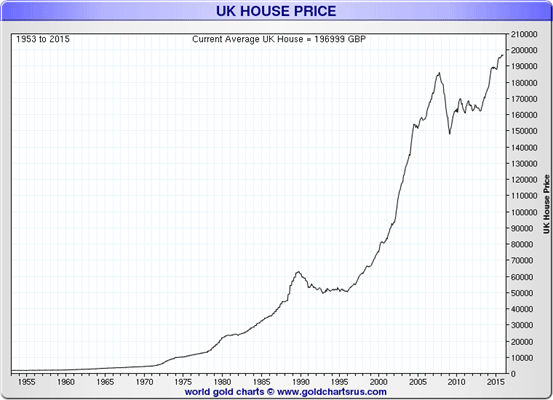The charts you love to hate: UK house prices - in gold

Rightmove declared this week that UK property asking prices have hit an all-time high, while last week gold had one if its monster days, the like of which we haven't seen for many years – up almost $70 per ounce on the day at one stage on Wednesday.
So today we do something we haven't done for many years. We tackle a subject that, I believe, holds the record for MoneyWeek's most commented-on article.
You wouldn't think it by its title, but it an issue that simultaneously fascinates and infuriates.
The ratio of house prices to gold.
The incredible, credit-fuelled rise of UK house prices
We'll start with a chart of UK house prices since the 1950s.

The key observation here is that the relentless, near-exponential rise in house prices accelerated in 1971. That was when the last restraints that gold imposed on the insidious forces of money supply growth were finally severed, with the US abandoning the Bretton Woods system.
More than anything else – be it lack of supply, lack of new-build, repressive planning regulations, mass immigration, whatever your bugbear – it is the money system that causes unaffordable house prices.
The money supply in the UK has risen 77-fold since 1971 (from £31bn then to £2.4trn). House prices, according to the Nationwide, have risen 42-fold (from £4,700 in 1971 to £197,000 today), and by a lot more in London.
House prices rose 9.7% last year, says the Halifax. It is the Bank of England's remit to deal with inflation, usually by raising interest rates. But, of course, house prices are ignored in the Bank's official measure, the consumer price index (CPI), which only measures the 10% of newly-created money that goes into consumer goods.
CPI does not reflect the 40% of newly-created money that goes into property (these numbers come from think tank Positive Money, by the way).
So the Bank can ignore house price rises, say there is no inflation and thus the base rate remains at 0.5%.
If rates instead reflected house price inflation of 9.7%, house prices would become affordable pretty sharply.
In London, the financial centre, and thus where most money gets created, the relationship is even more apparent. Look at what QE (quantitative easing) and Zirp (zero interest rate policy) have done to London house prices post-2009. 2008 was a major high for UK property, but in London it was a mere blip.

This might make you angry
Many people criticise the exercise of comparing the ratio of these two assets – gold and UK residential property.
But ratios are a quick way of detecting relative value. Particularly so in the case of gold, the function of which is to store wealth. You can't grow the gold supply with QE or loose lending, so it is not so easy to debase.
So we look at UK house prices relative to gold over the same period. (My thanks by the way go to Nick Laird of sharelyx.com for the charts.)
Gold is currently £835 an ounce. The average UK house price is £197,000. So it takes 235 ounces to buy the average UK house.
(The price has moved quite a bit over the past week – the chart below dates to the end of 2015.)

Here's where people get angry. In gold terms, UK house prices are the same price as they were in 1988 or in 1963, when it also took about 235 ounces of gold to buy the average UK house.
In 2004, the peak of UK house prices relative to gold, it took 720 ounces to buy the average UK house. In 1980 (on an intraday basis) and also in the 1930s, the ratio went to 50 ounces. So 50 to 720 ounces is the extreme range.
During gold's great bull market which ended in 2011, I had 200 ounces as my first target, which (from memory) I then lowered to 150 and then to 100.
As it turned out, 150 ounces was the point at which to move out of gold and into property. 2011-12 was the time to do it. Easy to see now.
For the last three years, property has been rising against gold, and I'd suggest that the 300 ounces of gold area is a pivotal point. I'm hoping (not a good investment strategy) that 300 marks the high, and that we get another wave of gold appreciation that takes the ratio to the 100 area.
Maybe we've already peaked at 275 ounces. We'll see. Maybe the coming political upheaval of the next three years will take us towards 100. (Or maybe we go back to the 2004 heights of 720 ounces. Nobody knows.)
In the short term – the next couple of months – I'm gold bearish. As 2017 gets closer, that view will change.
As for UK property, broadly speaking, I'm bullish. In many parts of the UK it is, in my view, cheap. There is a strong case for buying in the Midlands, in the North or the West – anywhere really except London, the South East and certain hotspots such as Bristol, where prices are out of all kilter.
London – as measured in gold
London is mad crazy expensive, whether relative to the rest of the UK or to earnings. Problem is though, everyone wants to live here.
The hope is that the hissing bubble in new builds (and by the way, I was the first journo onto that one) will bring down London property prices generally. We'll see about that one.
Here's the chart of London relative to gold since 1995.

Again 2004 was the peak, and 2011/12 the low. Currently, with gold at £835 and the average London property £514,000 (according the Land Registry), we're talking 615 ounces – so the price has come down quite a bit just this year.
London property price inflation has slowed. So if gold can hold above $1,200 (£800) then perhaps we've just seen a turn.
That's what I'm hoping. But who knows, maybe the trend resumes and we go all the way back to 2004 prices. It's possible. We'd need a bull market in sterling, the bear market in gold to resume, and another bull market in London property.
But if that happens, London property will be so unaffordable the government will have a 1799-style revolution on its hands.





